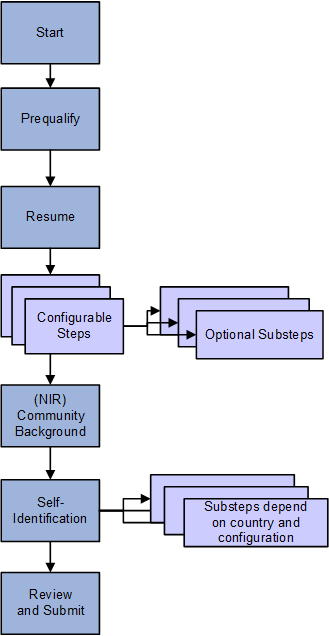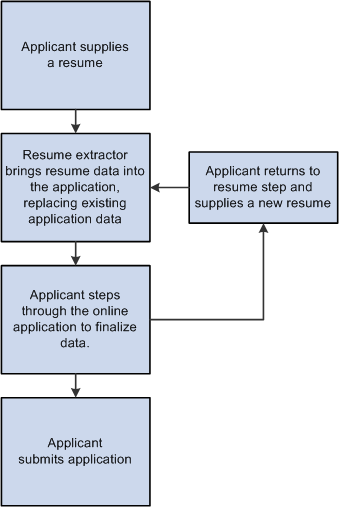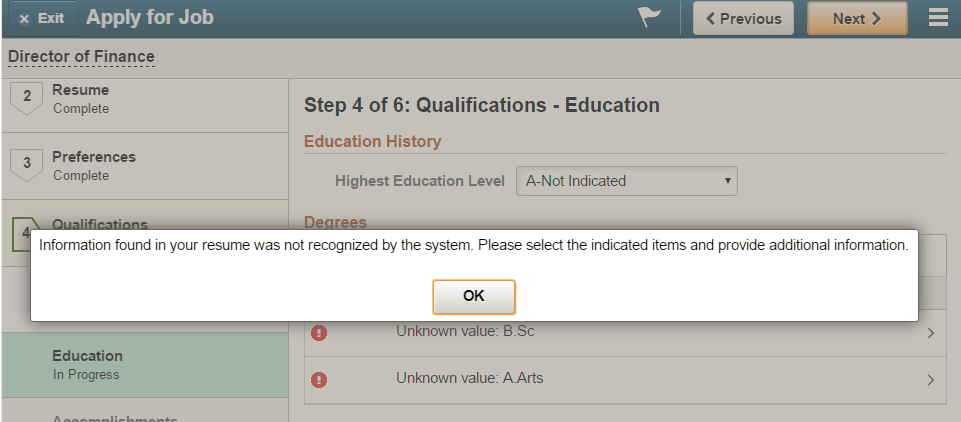Understanding the Application Process in Fluid Candidate Gateway
This topic provides overviews of:
The online application process in Fluid Candidate Gateway.
Default application data.
Integration with resume extractors.
Starting an Application
Depending on how the applicant initiates the application, the application can include one, multiple, or no job openings. These are the different ways that applicants can start a new job application:
Click Apply for Job button on the Job Description Page to start an application for a single job.
If the site is configured to allow applications without a job, click the Apply Without a Job link on the Search Jobs Page.
If the site is configured to allow applications with multiple jobs, select one or more jobs then click the Apply for Job button on the Search Jobs page or the My Favorite Jobs Page.
Note: On small form factor devices such as phones, applicants cannot select multiple jobs and start an application that includes all of them.
Applying for The Same Job Multiple times
The Site Setup page lets you configure whether to allow multiple applications for the same job. If multiple applications for the same job are allowed, applicants see a warning when they start a duplicate application, but they are allowed to continue with the new application. If multiple applications for the same job are not allowed, applicants see an error message and are not allowed to continue. The message tells the applicant to go to the My Job Applications page to review the existing application (or to restart it if the existing application is unsubmitted).
If an applicant created multiple applications for the same job opening before you activated the option to disallow multiple applications, the applicant will be able to continue with a draft application as long as there are no submitted applications for the same job opening.
Even if multiple applications for the same job are not allowed, applicants can reapply for jobs in these situations:
The original application was withdrawn.
The original application failed prescreening or online screening (that is, the application disposition is either 112 Failed Prescreening or 115 Reject Online Screening).
The original application was created when a recruiter linked the applicant to a job with a questionnaire. In this situation, the original application does not include questionnaire answers, and the applicant is specifically invited to submit a new application so that questionnaire answers can be provided.
Resume Template Selection
Resume templates control several of the steps in the application process. The system loads resume template settings as follows:
If an applicant applies without selecting a job opening, the system uses the default resume template that is associated with the site.
If the applicant applies for a single job opening, the system uses the resume template for that job opening.
If an applicant applies for more than one job at a time, the system merges the associated resume templates so that all sections are included in the application (but no sections are duplicated).
Steps in the Online Application Process
Candidate Gateway guides applicants through the steps in the job application.
The site definition, the resume template, and the job opening(s) can all impact the steps that appear during the application process. Although configuration options affect which steps appear, the overall sequence of steps is fixed, as shown in the following diagram.
See The Activity Guide Framework for Job Applications.
This diagram illustrates the sequence of steps during the job application process.

The following table describes the application steps and explains what causes each step to appear.
|
Step |
Description |
Conditions When the Step Appears |
|---|---|---|
|
Start |
Displays notices and provides a link to terms and conditions. If terms and conditions apply, the applicant must agree to the terms before continuing to the next step. |
The start steps appears if either of the following conditions is true:
|
|
Prequalify |
Displays prescreening questions. Depending on the site configuration, the applicant may be required to supply answers before continuing. When the applicant continues to the next step, the system evaluates the answers.' If the applicant passes prescreening for all jobs, the applicant continues directly to the next step. If the applicant fails prescreening for at least one job, the system displays a message with the prescreening results. Jobs where the applicant fails prescreening are removed from the application. If no jobs are left in the application, the applicant cannot continue. If at least one job is left in the application, the applicant can continue, and system updates the list of steps to remove any that are no longer relevant to the remaining job openings. |
The Prequalify step appears when either of the following conditions is true:
|
|
Resume |
Enables applicants to supply a resume and cover letter using methods defined in the resume template. Fluid Candidate Gateway does not allow applicants to copy and paste resume text into an application regardless of the resume template settings. |
The Resume step appears unless the resume template is configured to skip this step. |
|
Configurable steps |
These steps, which are configured on the resume template, can display any of the following data entry sections:
|
Resume templates define the configurable steps (and optional substeps) in the application process. |
|
(NIR) Community Background |
Enables applicants for jobs in Northern Ireland to enter their community background information. |
The Community Background step appears if the Use Community Background check box is selected on the Country Specific page in the resume template definition. The system does not consider the actual location of the job opening, only the settings on the resume template. |
|
(USA) Self-Identify (external applicants only) |
Includes up to three substeps that are all related to United States regulatory requirements:
The Veteran and Disability steps both relate to regulations from the U.S. Department of Labor’s Office of Federal Contract Compliance Programs (OFCCP). |
The Self-Identify step appears only for USA job applications. Applications are considered USA job applications if any of the included job openings have recruiting locations that are associated with a physical location in the United States. If a job opening’s recruiting location doesn't reference any physical locations, the job is not treated as being in the United States. If an applicant applies without a job opening, the application is considered a USA job application if the applicant's address is in the United States. All applicant records have a Country in the address, even if no other address information exists. For information on default values for the Country field, see Understanding Account Information. The Diversity substep is not configurable, so it appears in all USA job applications. The Disability and Veteran substeps appear only when activated in the OFCCP Self-Identify field on the Site Setup Page Note: If the Disability and Veteran substeps are not enabled, then Diversity appears as a main step instead of a substep. |
|
Review and Submit |
Enables applicants to review their application before submitting it. |
The Review and Submit step is the only required step for every application. It is not configurable. |
Draft Applications
Applications that have been saved without being submitted are considered draft applications. Draft applications have the status Not Submitted on the My Job Applications page.
The system automatically saves application data every time an applicant moves to a different step in the application process. An application is also saved when an applicant clicks either the Exit button or the Save as Draft item under the Actions List. However, the application is not saved if applicant exits from the Start Step without ever continuing to the next step.
With two exceptions, an applicant who re-opens a draft application is placed on the last saved step.
The first exception relates to the self-identification and Northern Ireland community background steps. Information on these steps does not get saved until the application is submitted. This is because the information is saved directly to the applicant record rather than being part of an individual application. Therefore, if an applicant continued past these steps before exiting the application, the application re-opens on the first one of these steps so that the applicant can re-enter the information.
The second exception relates to changes that require the applicant to re-start at the beginning. The system returns the applicant to the Start step if any of the following configuration changes have occurred since the application was saved:
Changes to any Start Step notices or terms and conditions.
These changes occur if there are text changes within the relevant text catalog entries or if changes to the site configuration affect which Start Step text is visible.
Changes to the application steps due to resume template changes.
When the system returns the applicant to the Start step, the applicant’s previously entered data is preserved, but the applicant must still revisit each step.
Submitted Applications
After applicants submit an application, they cannot make changes to it.
Submitted applications have the status Submitted on the My Job Applications Page.
When an applicant accesses a submitted application, the system displays read-only application data on the Application Summary Page.
Application-Related Notifications
When an application is submitted, the system sends a confirmation email to the applicant. This behavior is not configurable. The notification uses the HRS_CE_APPL_APPLY_JOB template.
Settings on the Job Opening - Screening Criteria Page control whether the system sends applicant email with results of prescreening and online screening.
When applicants start new applications, the default data depends on whether the applicant is external or internal.
External Applicants
If an external applicant already has any existing draft or submitted applications, new applications copy data from previous applications. The system does not bring in a resume, answers to questions, competency ratings, or referral information. For other sections, the system copies data from the most recent application that included the section, regardless of whether the most recent application was submitted, unsubmitted, or withdrawn.
Self-identification data (diversity, disability, veteran, and Norther Ireland community background) is copied from the applicant record, not from other applications. Self-identification data is saved to the applicant record when an application is submitted.
Internal Applicants
When internal applicants create new applications, the system copies data from their employee profiles (including training information) and then adds additional non-conflicting data from the most recently created application.
For example, if an employee adds profile content in an application, the new data gets brought into the next new application. But if an employee removes or modifies profile content that came from the HR system, the next new application will still bring in the original profile content as long as it remains in the employee’s HR record.
Work experience data from an internal applicant’s previous applications does not get brought into new applications. For internal applicants, work experience is brought in only from the employee’s human resources record (as seen on the Prior Work Experience Page).
This topic provides a general overview of the use of resume extractors to populate the online application fields. For information about setting up resume extractors, see Setting Up Recruiting Vendors and Setting Up Data Mapping.
The Resume Extraction Process
If you integrate with a third-party resume extractor, the extraction process parses data from the applicant's resume attachment and populates application fields automatically.
See Understanding Resume Management.
The following diagram shows how a resume extractor is used during the online application process. The extractor uses resume information to enter default values into the application form. While proceeding through the remaining steps, the applicant can review and modify the data provided by the resume extractor.

Here is how resume extraction works:
An applicant uploads a resume.
The resume extractor parses the resume and enters data in the appropriate application fields.
Parsing occurs immediately after the resume is added to the application; the applicant does not need to continue to the next step
Data from the resume parsing process overwrites any existing application data, including the default data that the system imports from a previous application or from an employee profile.
Applicants continue to step through the online application process, reviewing data and supplying any missing information.
Sometimes the resume parsing process will create a row of data that is missing required information. In this situation, the system prevents the applicant from moving past the step with the missing information until all required data is supplied. A red warning icon identifies the incomplete data, and the applicant must resolve the issue before continuing to the next step.
If an applicant returns to the resume step and supplies a new resume, the newly extracted data replaces the previous data, and the applicant must go through each application step again to verify the newly extracted information.
This example illustrates the error handling when the resume parser creates a row of data that is missing required information.

Extracting Contact Data
Because applicant records in Candidate Gateway allow only one address, resume addresses are added only if the applicant record does not already have one. If the resume includes multiple addresses, only the first is added.
Candidate Gateway does support multiple email addresses and phone numbers, but it allows only one of each type (for example, one home phone number).
If an email or phone type is already in use (for example, the extractor finds a home phone number, but one already exists in the system), then the new email or phone number is added using the type Other. If the Other type already exists, it is overwritten, and any additional email or phone numbers in the resume are ignored.